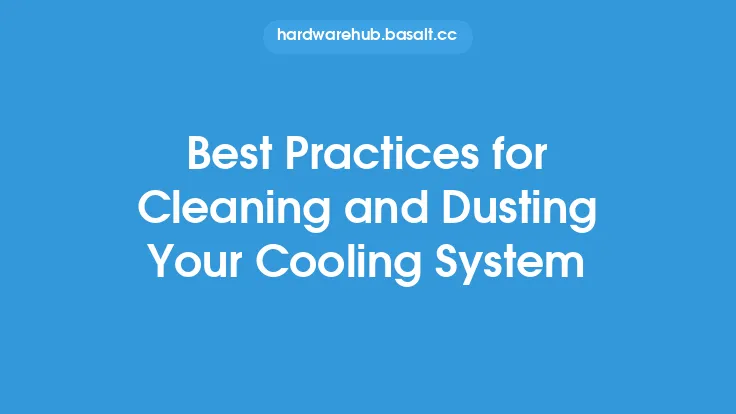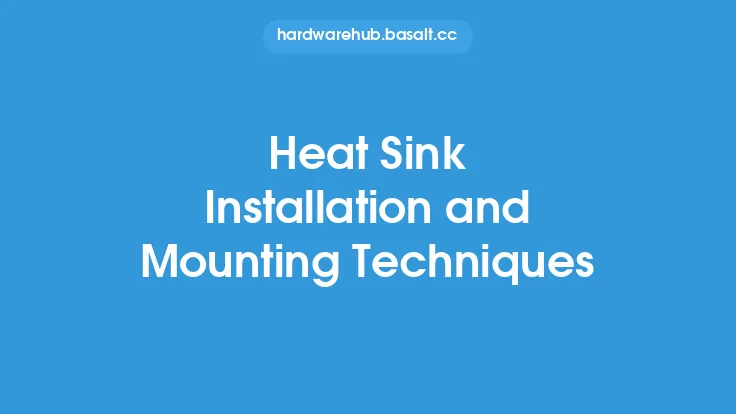Proper maintenance and cleaning of heat sinks are crucial to ensure optimal performance and longevity of the cooling system. Over time, heat sinks can accumulate dust, dirt, and other debris, which can significantly reduce their ability to dissipate heat. In this article, we will discuss the best practices for heat sink maintenance and cleaning, including the tools and techniques required to keep your heat sink in top condition.
Introduction to Heat Sink Maintenance
Heat sink maintenance is an often-overlooked aspect of cooling system upkeep. However, it is essential to regularly inspect and clean heat sinks to prevent the buildup of debris and ensure maximum heat transfer. Neglecting heat sink maintenance can lead to reduced cooling performance, increased temperatures, and potentially even system failure. In addition to cleaning, heat sink maintenance also involves inspecting the heat sink for signs of wear and tear, such as corrosion, bent fins, or loose mounting screws.
Cleaning Methods and Techniques
There are several methods and techniques for cleaning heat sinks, depending on the type of heat sink and the level of debris buildup. For lightly dirty heat sinks, a soft-bristled brush or a can of compressed air can be used to gently remove dust and debris from the fins and surfaces. For more heavily dirty heat sinks, a mild detergent and water solution can be used to clean the heat sink, followed by a thorough rinsing with distilled water. It is essential to avoid using harsh chemicals, abrasive materials, or high-pressure water jets, as these can damage the heat sink or its finish.
Tools and Materials Required
To clean a heat sink, you will need a few basic tools and materials. These include a soft-bristled brush, a can of compressed air, a mild detergent, distilled water, and a soft, lint-free cloth. For more heavily dirty heat sinks, you may also need a toothbrush or a small, soft-bristled brush to clean hard-to-reach areas. It is also recommended to wear gloves and work in a well-ventilated area to prevent skin irritation and inhalation of dust and debris.
Step-by-Step Cleaning Procedure
To clean a heat sink, follow these steps:
- Shut down the system and unplug the power cord to prevent any accidental startups or electrical shocks.
- Remove any dust filters or grills to access the heat sink.
- Use a soft-bristled brush or a can of compressed air to gently remove any loose dust or debris from the fins and surfaces.
- If the heat sink is heavily dirty, mix a mild detergent and water solution, and use a soft, lint-free cloth to wipe down the heat sink.
- Rinse the heat sink thoroughly with distilled water to remove any soap residue.
- Use a soft, lint-free cloth to dry the heat sink and prevent water spots.
- Inspect the heat sink for any signs of wear and tear, such as corrosion, bent fins, or loose mounting screws.
- Reassemble the system and plug in the power cord.
Special Considerations for Different Types of Heat Sinks
Different types of heat sinks may require special cleaning considerations. For example, heat sinks with delicate or intricate fin designs may require more gentle cleaning techniques to prevent damage. Heat sinks with copper or aluminum surfaces may require specialized cleaning solutions to prevent corrosion or discoloration. Additionally, heat sinks with thermal interface materials (TIMs) may require special cleaning techniques to prevent damage to the TIM.
Preventative Maintenance and Scheduling
To prevent debris buildup and ensure optimal heat sink performance, it is recommended to schedule regular cleaning and maintenance. The frequency of cleaning will depend on the environment and usage of the system. For example, systems used in dusty or dirty environments may require more frequent cleaning, while systems used in clean environments may require less frequent cleaning. It is also recommended to inspect the heat sink regularly for signs of wear and tear, and to perform any necessary repairs or replacements.
Conclusion
Proper heat sink maintenance and cleaning are essential to ensure optimal performance and longevity of the cooling system. By following the best practices outlined in this article, you can keep your heat sink in top condition and prevent debris buildup, corrosion, and other issues that can reduce cooling performance. Remember to always use gentle cleaning techniques, avoid harsh chemicals and abrasive materials, and schedule regular cleaning and maintenance to ensure optimal heat sink performance.





